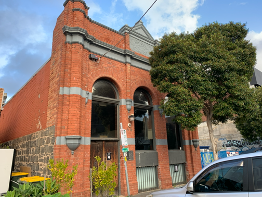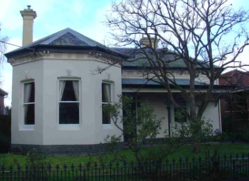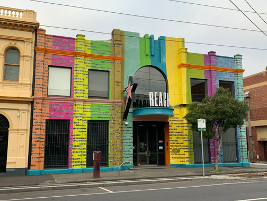Collingwood Notables Database
John Prescott Dyason
1855 - 1936
Cordial and sauce manufacturer, councillor
John Dyason was a manufacturer who became well-known in the Collingwood district for his firm’s cordials, preserves, sauces and jams. He has left a delightful architectural legacy in the remaining Dyason and Son’s factory, at 44 Oxford Street, Collingwood. John was the tenth child of Joshua Dyason, the founder of the firm. His middle name, Prescott, was supposedly bestowed on the boy to reflect his father’s pride in securing the sole colonial agency for Prescott’s Parramatta Lime Juice. This famous West Indian lime juice was not only a refreshing beverage but was also supposed to prevent scurvy.
While the Dyason brand was to be found in several other states, managed by John’s older brothers, John became the mainstay of the Melbourne operation. Joshua took him on as a partner in 1877, by which time Joshua was renting a shop in Stanley Street, Collingwood. As well as ‘Exo’, a drink patented by Joshua, they made lime cordial, raspberry vinegar, and all manner of syrups. Lime juice was advertised on a weekly basis in the Mercury and Weekly Courier as a ‘pleasant wholesome & refreshing beverage’ ‘Highly beneficial to rheumatism, and strongly recommended for heat in blood and skin.’
By 1882 Joshua and John had re-located the business in two wooden houses which Joshua had purchased at 61- 63 Cambridge Street. Shortly afterwards John bought a house in Oxford Street which backed on to the Cambridge Street site. In 1887 the partnership was dissolved, although the name Dyason and Son remained. Joshua was perhaps in ill health, as he died in May 1888, thus missing the 1889 construction of a new factory at 44 Oxford Street on the site of John’s demolished house. Not long after this John also began renting a factory and yard in nearby Dorset Street (off Wellington Street) from local publican Abraham Howgate, a site that would be greatly expanded in the twentieth century.
In the meantime John had married Mary Ann Manser in 1880. Although according to family recollections the family were Methodist, the ceremony was performed by the Reverend Charles Cherbury of the Sackville Street Baptist Tabernacle, at the minister’s house in Greeves Street Fitzroy. Mary, a beautiful woman and an accomplished musician and singer, in ensuing years passed on her attainments to her large family. The couple lived in Budd Street Collingwood, then in Cambridge Street, before buying the Oxford Street house. During this period their first five children were born. Not long after Joshua’s death they moved to the up-and-coming suburb of Clifton Hill, briefly renting a cottage in Gold Street before moving to a substantial weatherboard house at 5 Berry Street, on a large block of land with stables opening from Lilly Street. But it was not many years before John bought yet another house, on the opposite side of the road. Now numbered 24, this is a double-fronted rendered Italianate style house, which originally stood on more land (now occupied on the south side by a twentieth century house). Here the stables were accessed from a lane off Caroline Street, this lane also providing rear access to the house at 5 Abbott Grove where John’s mother moved after his father’s death. Four more children were born, before the Dyasons moved to Hawthorn in the late 1890s and their last son Collis was born.
Dyason’s commercial and family activities still left him time to take an interest in civic affairs. In June 1894 he stood for council in the extraordinary election resulting from the resignation of Councillor Feild as the Loch ward representative. He won by a very comfortable margin ahead of local barrister Harold Petherick, was re-elected in 1896, resigned in 1898 in order to spend some months in Sydney, and was re-elected in 1900.
The twentieth century saw the company going from strength to strength. Extensive alterations and additions were made to the Oxford/Cambridge Streets factory in 1903, designed by Richard Malvern Guthridge to form one large factory complex including stables. The current Cambridge Street frontage dates from this period and incorporates some similar design elements to the Oxford Street frontage, though the upper floor was added later.
Dyason had added tomato sauce and chutney to his manufacturing repertoire; some of the ingredients were grown on land John had purchased in Gippsland. The products received favourable comments, especially for their lack of preservatives. In 1906 the firm received massive orders from Queensland, New South Wales and India; 15 heavily laden lorries were needed to transport the goods to the wharves (probably the event depicted in the Oxford Street photo below). In 1907 the firm’s first annual picnic was written up in the Australian Brewers Journal. Staff travelled in five drays to South Morang, where a range of sports, entertainments, and meals was supplied until 9:15 pm. John, now in his early 50s, was the winner of the ‘Old Buffers’ running race.
In 1910 the Oxford/Cambridge Street complex was sold to Joseph Timms and Son, a smallgoods manufacturer. The Dyason business moved to the site in Wellington Street and Dorset Street where John had begun renting property some years earlier. In 1911 Councillor William Rain designed a new factory and extensive alterations and the address became 154-160 Wellington Street, an L-shaped site wrapping around Singleton’s Dispensary to Little Smith Street (now Singleton Street). In 1912 Timms put up the old site for sale and it was again occupied by a sauce manufacturer, the Derrick Manufacturing Company.
John’s eldest son Alfred had trained as an analytical chemist and played an important role in the firm until 1911, when he left to become a Seventh Day Adventist preacher. Later, he took on the role of food analyst for Sanitarium Foods. Whether or not John was a teetotaller has yet to be ascertained, but Alfred had been a member of a Rechabite group from boyhood, along with his brother Horace.
By 1915 cracks began to appear in the run of success. A meeting of creditors of Dyason Pty Ltd was held, and the firm went into liquidation. But with intimations of expansion in business, a new and larger company named Cockatoo Preserves Limited took over the assets and liabilities and carried on, with Thomas Press continuing as the managing director. They purchased an adjoining block of land 65 x 350 feet, on which William Rain designed a large brick and iron bulk store, and built an extra floor above the factory. In 1916 they received a large number of orders from the Imperial War Office, for example, two million pounds weight of jam and continued successfully for several years, acquiring neighbouring houses and the former Studley Arms Hotel at 252 Wellington Street. In 1921 this new company was also to be wound up; family sources believe John’s shareholding in the company ceased around this time. The Studley Preserving Company Pty Ltd purchased the Cockatoo assets and continued to sell the brands of Cockatoo Preserves, Dyason’s, and Prescott’s. By late 1935 the downward spiral had again begun and this company went into voluntary liquidation: a slow process over two years as jam making, fruit preserving and can-making machinery was auctioned off, followed by office machinery. Finally in early 1938 the old factories surrounding Dorset Street were bought by Davies Coop, a textile manufacturer, and the long reign of preservers ceased.
With so many construction and ownership changes occurring over the years, it is difficult to pinpoint precisely the dates of the current Wellington Street buildings, which now consist of a two storey building on the main frontage and an enormous factory complex at the rear.
The heritage listed Dyason Oxford/Cambridge Street complex remains in part, but the middle section has been demolished (2020) and a massive development is about to be constructed over and around it.
Dyason drays, probably 1906
44 Oxford Street
24 Berry St
154 - 158 Wellington Street
Life Summary
| Birth Date | Birth Place |
|---|---|
| 1855 | Brunswick, Victoria |
| Spouse Name | Date of Marriage | Children |
|---|---|---|
| Mary Manser, 1858 - 1950 | 1 April 1880, 49 Greeves Street, Fitzroy | Alfred 1880, Horace 1882, John 1884, Tassell 1885, Myrtle 1888, Norman 1891, Henry 1892, Dora 1894, Clifford 1895, Collis 1897 |
| Home Street | Home City | Status of Building |
|---|---|---|
| Budd Street NE corner Easey Street | Collingwood | Demolished |
| 65 Cambridge Street | Collingwood | Demolished |
| 16 (now 44) Oxford Street | Collingwood | Demolished |
| 136 Gold Street | Clifton Hill | Extant |
| 5 Berry Street | Clifton Hill | Demolished |
| 24 Berry Street | Clifton Hill | Extant |
| Work Street | Work City | Status of Building |
|---|---|---|
| Stanley Street | Collingwood | Demolished |
| 61 - 63 Cambridge Street | Collingwood | Demolished |
| 44 Oxford Street and 63 Cambridge Street | Collingwood | Extant |
| 154 - 158 Wellington Street | Collingwood | Extant |
| Church | Lodge |
|---|---|
| United Grand Lodge of Freemasons |
| Death Date | Death Place | Cemetery |
|---|---|---|
| 26 July 1936 | Glen iris | Melbourne General Cemetery |
Dyason, Dyasons in Australia: the family tree; Dyason, Melon and lemon jam; Melbourne and its metropolis; Illustrated Australian News; The Argus; The Age; Leader; Punch; The Mercury and Weekly Courier; The Herald;Advocate; The Australasian; The Evening Echo (Ballarat); The Ballarat Star.
Cockatoo properties for sale 1938
Trove lists: “John Dyason” Joshua Dyason” “Cockatoo Preserves” “Studley Preserving Company”.





